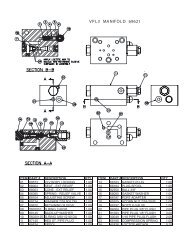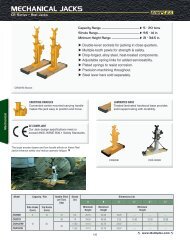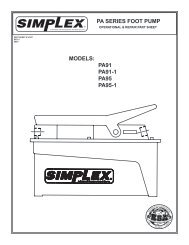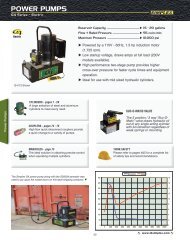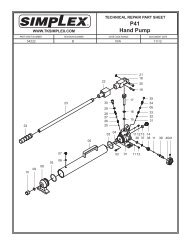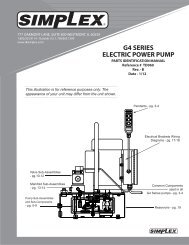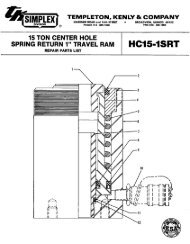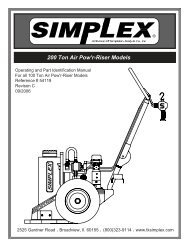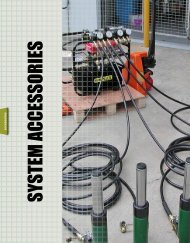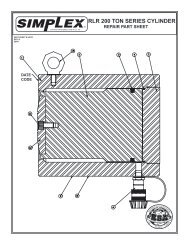please read and understand this manual before using ... - Simplex
please read and understand this manual before using ... - Simplex
please read and understand this manual before using ... - Simplex
Create successful ePaper yourself
Turn your PDF publications into a flip-book with our unique Google optimized e-Paper software.
HEAVY LIFT BAGS INSTRUCTION MANUAL<br />
WARNING!<br />
Before <strong>using</strong> Lifting Air Bags, carefully <strong>read</strong> these instructions. Non-compliance with recommendations can<br />
result in product damage <strong>and</strong> personal injury.<br />
Never work under a load without safety supports<br />
Never exceed the inflation pressure of 8 bar (118 PSI)<br />
Never place more than two lifting air bags one upon another<br />
Information<br />
This booklet contains technical information about lifting air bags <strong>and</strong> basic instructions for use. The selection<br />
<strong>and</strong> application of air bags depend on various factors such as lifting requirements, capacity, lifting height, <strong>and</strong><br />
shape of objects. The manufacturer doesn't assume any responsibility for personal injuries or material<br />
damages arising from improper use or misuse of lifting air bags <strong>and</strong> their constituents. The figures beside the<br />
text are shown for information only. Actual conditions of lifting techniques <strong>and</strong> characteristics depend on the<br />
particular application.<br />
Recommendations for safe <strong>and</strong> efficient work<br />
When <strong>using</strong> air bags, always wear protective clothing. Firemen <strong>and</strong> rescue-team members must be equipped<br />
completely in accordance with all requirements; other users should wear safety helmet, safety glasses <strong>and</strong><br />
gloves or other equipment if required.<br />
Proper transportation of air bags is of great importance. Care should be taken that air bags are always being<br />
carried with the inflation nozzle facing upwards to avoid impact damage to the inflation mechanism. Large,<br />
heavy air bags are to be carried by two persons. When air bags are stored or transported in horizontal position,<br />
the inflation nozzle must face a direction so that it can be easily seen when an air bag is to be moved, <strong>and</strong> that<br />
the work can be done safely without risk of damage.<br />
When the surface temperature of the object to be lifted exceeds 55°C (131°F), the part of the air bag in contact<br />
with the object is to be protected by means of a fiberboard. Heat <strong>and</strong> temperatures exceeding the permissible<br />
level can damage the air bag. Alternatively, in cold conditions, air bags have been tested <strong>and</strong> proven to<br />
perform as specified to at least -20°C (-4°F)<br />
Even though it is simple to place <strong>and</strong> to inflate the air bag in the dark, it is dangerous. The work area should be<br />
well illuminated. Sometimes, when due to the effect of shading or poor visibility during the day it is<br />
recommended to use additional sources of light.<br />
High-pressure cylinders <strong>and</strong> pressure regulators<br />
Every time the pressure regulator is attached to a cylinder the following safety <strong>and</strong> operating precautions must<br />
be used. Deviation from the following safety <strong>and</strong> operating instructions may result in fire, explosion, damage to<br />
the regulator or injury to the operator.<br />
High-pressure cylinder/regulator care<br />
1. Before removing the protective cap, secure the cylinder to a wall, post or cart to prevent it from falling.<br />
2. Inspect the cylinder valve for damaged th<strong>read</strong>s, dirt, dust, oil or grease. Remove contamination with a<br />
clean cloth.<br />
3. Crack open the cylinder valve for an instant to blow out dust <strong>and</strong> foreign matter that could clog or<br />
damage the regulator. Do not place any part of your body near the airflow, as high-pressure air-jetseven<br />
at relatively low velocity-have been known to tip the cylinder over, accelerate projectiles,<br />
penetrate skin, dislocate eyeballs <strong>and</strong> cause other serious injury.<br />
2 of 9




